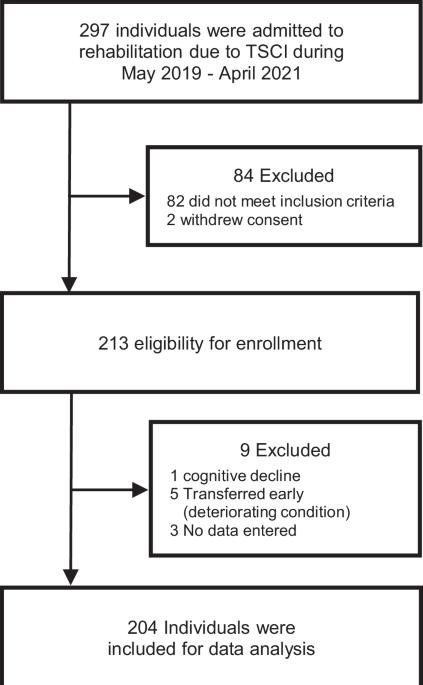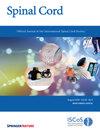损伤严重程度与康复干预对脊髓损伤患者日常生活活动独立性的影响
IF 2.2
4区 医学
Q3 CLINICAL NEUROLOGY
引用次数: 0
摘要
研究设计:对观察资料进行纵向二次分析。目的:探讨物理(PT)和职业治疗(OT)干预在提高脊髓损伤(SCI)患者脊髓独立性测试III (SCIM III)评分中的有效性。地点:日本的两个SCI中心。方法:记录9个时间点(72 h;2、4、6周;以及损伤后2、3、4、5和6个月)。总共纳入了204名参与者,并根据入院严重程度分为四组。使用线性混合效应模型,使用SCIM III评分作为因变量评估PT和OT干预的有效性(由国际脊髓损伤物理治疗-职业治疗基本数据集定义)。结果:以下项目显示了严重程度和治疗时间在SCIM III评分中的交互作用:PT和OT的[力量训练],OT的[站立控制活动]和[大运动上肢]。无论严重程度如何,观察了PT的[床/坐的控制活动]、[行走和爬楼梯]、[大运动上肢]和OT的[精细运动上肢]的干预效果。结论:研究结果表明,考虑损伤严重程度与康复干预之间的相互作用对于优化治疗方案和确定适当的干预时机至关重要。这些发现可能支持临床决策,并有助于改善脊髓损伤患者的功能预后。本文章由计算机程序翻译,如有差异,请以英文原文为准。

Interaction between injury severity and rehabilitation intervention on independence in activities of daily living in persons with spinal cord injury
Longitudinal secondary analysis of observational data. To examine the effectiveness of physical (PT) and occupational therapy (OT) interventions in improving Spinal Cord Independence Measure III (SCIM III) scores among individuals with spinal cord injury (SCI). Two SCI centers in Japan. The content and time of rehabilitation interventions, and International Standards for Neurological Classification of SCI and SCIM III scores, were recorded at nine time points (72 h; 2, 4, and 6 weeks; and 2, 3, 4, 5, and 6 months after injury) for hospitalized individuals with SCI. Overall, 204 participants were included and categorized into four groups based on admission severity. Using a linear mixed-effects model, the effectiveness of PT and OT interventions — defined by the International Spinal Cord Injury Physical Therapy-Occupational Therapy Basic Data Set — was assessed using the SCIM III score as the dependent variable. The following items showed interaction effects between severity and treatment time for the SCIM III score: [Strength training] for PT and OT, and [Standing control activities] and [Gross motor upper extremity] for OT. Intervention effects were observed for [Bed/seated control activities], [Walking and stairs], and [Gross motor upper extremity] for PT, and [Fine motor upper extremity] for OT, regardless of severity. The results suggest that considering the interaction between injury severity and rehabilitation interventions is essential for optimizing treatment plans and determining appropriate intervention timing. These findings may support clinical decision-making and contribute to improving functional outcomes in individuals with SCI.
求助全文
通过发布文献求助,成功后即可免费获取论文全文。
去求助
来源期刊

Spinal cord
医学-临床神经学
CiteScore
4.50
自引率
9.10%
发文量
142
审稿时长
2 months
期刊介绍:
Spinal Cord is a specialised, international journal that has been publishing spinal cord related manuscripts since 1963. It appears monthly, online and in print, and accepts contributions on spinal cord anatomy, physiology, management of injury and disease, and the quality of life and life circumstances of people with a spinal cord injury. Spinal Cord is multi-disciplinary and publishes contributions across the entire spectrum of research ranging from basic science to applied clinical research. It focuses on high quality original research, systematic reviews and narrative reviews.
Spinal Cord''s sister journal Spinal Cord Series and Cases: Clinical Management in Spinal Cord Disorders publishes high quality case reports, small case series, pilot and retrospective studies perspectives, Pulse survey articles, Point-couterpoint articles, correspondences and book reviews. It specialises in material that addresses all aspects of life for persons with spinal cord injuries or disorders. For more information, please see the aims and scope of Spinal Cord Series and Cases.
 求助内容:
求助内容: 应助结果提醒方式:
应助结果提醒方式:


